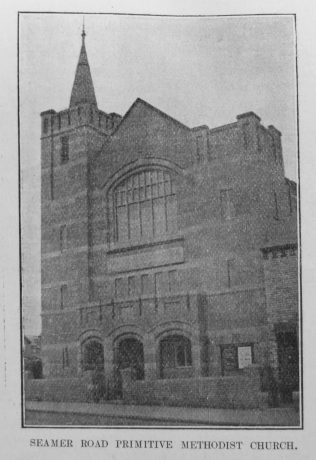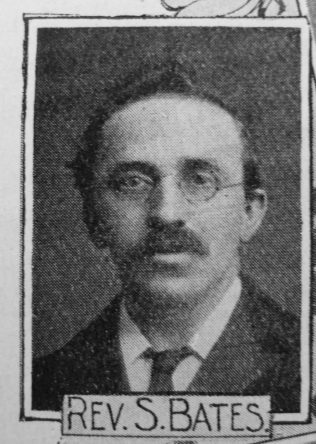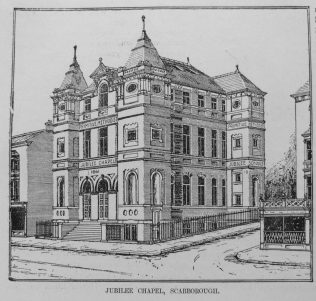Scarborough: Primitive Methodism in Scarborough










Transcription of Article in the Primitive Methodist Magazine by Henry Carden
SCARBOROUGH, the Conference town of 1905, is one of the strongholds of Primitive Methodism, the work there being the outgrowth of the missionary enterprise of William Clowes. After he had established the work which has grown to such magnificent proportions in the City of Hull, he turned his face northward, visiting the towns on the east coast.
His journal gives the following account of his first visit to Scarborough: “On Saturday, January 27th, 1821, by an unexpected providence my way was opened to preach at Scarborough. At seven o’clock I preached in Mr. Lamb’s schoolroom, and again on Sunday, the 28th, at ten in the morning; in the afternoon in the open air, and at six o’clock again in the schoolroom to more than could well get in.” A fortnight later Mr. Clowes spent another Sunday there, preaching morning and evening in the schoolroom, and in the afternoon by the seashore to a large congregation. On the following evening he preached again, and formed a society of nine members. A fortnight later he paid a return visit, again preaching morning and evening in the schoolroom, and in the afternoon by the sea. At night one got liberty, and four joined the society. Mr. Clowes visited several places in the locality during the week, returning to Scarborough for the Sunday morning, spending the afternoon and evening at Seamer, where a society had been formed. The work of William Clowes was followed up by Nathaniel West, who came from Whitby to spend a fortnight at Scarborough, during which time he added twenty-six to the infant cause.
John Abbey arrived on the scene on April 21st, and remained for eleven weeks, labouring so arduously and successfully that in that time no less than one hundred and sixty members were added to the town and village societies. William Clowes records that visiting Scarborough in the July of that year he found more than one hundred members in society there.
A chapel was erected during the year 1821. It was a modest structure, and was erected on the site of an ancient Franciscan Convent in St. Sepulchre Street. It was constructed in the shape of the letter T; the west wing being used as a schoolroom, in which a flourishing Sunday School was soon established.
Other early preachers associated with the work in Scarborough were Samuel Smith, Sampson Turner, Thomas Ellerker, George Stansfield, William Howcroft, John Hutchinson, Joseph Peart, George Summers, Robert Howcroft, J. Harrison, F. Baker, D. Beatie, J. Eckersley, none of whom appears to have remained beyond three months, their uniform salary being nine shillings per week. From the year 1832 to 1852 when Scarborough was a branch of the Hull Circuit, we find the names of William Sanderson, S. Smith, John Flesher, John Bywater, William Garner, Thomas Newsome, Thomas Cheeseman, and William Harland, among the superintendents.
Special interest attaches to the name of William Harland. He was one of the first-fruits of the labours of William Clowes in the locality. After his first Sunday spent in Scarborough, Clowes went on to Whitby, preaching on his way at Robin Hood’s Bay, William Harland, who was a schoolmaster at Cloughton, a village five miles from Scarborough, was present at that service; was deeply convicted of sin, and soon after found peace. He opened his schoolroom at Cloughton for preaching services; became a local preacher, and in due time, one of our most useful and distinguished ministers. He superintended the Scarborough Branch from 1849 to 1852, in which year Scarborough was made a circuit, and William Harland remained for two years its superintendent, so that in those days when frequent changes was the rule, he had the distinction of remaining for five years on his native station. In the year 1840, while John Flesher was superintendent, the original chapel, which had previously been enlarged, was superseded by a more substantial and commodious building, erected on the same site, and capable of seating seven hundred persons. Nothing more was done in the way of chapel extension in the town till the year 1860, when the Jubilee Chapel, which has been the scene of such glorious triumphs over the powers of darkness, was erected. The site secured was one of the finest in the town. The cost was £4,000.
The chapel erected provided sitting accommodation for more than a thousand worshippers. Hugh Campbell was the leader in this forward movement, which was the starting of a new era of progress in the town.
Unfortunately he was not permitted to see its completion, his useful life being cut short as the result of a street accident. His place was filled by Thomas Greenbury, and the chapel was opened on April 21st, 1861. It was only five years later that the present handsome and commodious building was erected as the third chapel on the original site in St. Sepulchre Street. This bold project was carried out under the superintendency of the Rev. Thomas Whitehead, who on the last occasion of the Conference meeting within its walls was placed in the presidential chair. It will be a great pleasure to the few who remain who were associated with him in this important enterprise of forty years ago, to see his venerable form at the forthcoming conference, as he sits in the place of honour granted to him by the Deed Poll.
Since the erection of Jubilee and the present Conference Chapel, as seen by the illustrations here given, there have been further developments in chapel building. As the outgrowth of cottage services we have the well positioned and prosperous church on St. John’s Road. First, the school chapel, now the schoolroom, followed by the present commodious chapel. Gladstone Road schools and school chapel, to which a fine corner site for future development is attached, was erected as an‘ off-shoot from Jubilee; while as the outgrowth of a mission and school chapel on the Seamer Road, there has during the past year been added the present church with a good supply of class rooms.
Three years ago Jubilee trustees carried out a bold improvement scheme, by placing a schoolroom and thirteen class rooms on top of the chapel. The addition has not only provided a long felt need for school work, but has added much to the improved appearance of the building, both internally and externally. Our chapel and school property is valued at £21,750, the present debt being £5,900.
Beside chapel extension considerable attention has been given to other branches of Christian Work. Primitive Methodism with its five churches, connected with which is a membership of 1,200; with prosperous Sunday Schools, Christian Endeavours, Mission Bands, Mothers’ Meetings, and other useful institutions, is by no means an unimportant factor in the religious life of the town; and by such men as Councillor W. Boyes, Councillor D. Maynard, and Mr. J.L. Hopwood, who has served for years both as Councillor and Alderman of the Borough, Primitive Methodism has contributed considerably to the civic life of Scarborough.
In the year 1896 the Scarborough Circuit was divided. St. Sepulchre Street, St. John’s Road, and Seamer Road are in the First Circuit, the ministers being the Revs. Tom Buttrick, G.C. Sharpe, with William Wright, sup. In pastoral charge of Seamer Road, and Mr. George Porrill, doing excellent work as a missionary in connection with St. Sepulchre Street Church.
Jubilee and Gladstone Road are the town places of the second Circuit, the present ministers being the Revs. Henry Carden and Samuel Bates. The Conference meets in Scarborough this year for the third time. The first was in 1877, and the second in 1887. Of the sixty-two ministers who were members of the 1877 Conference, only William Robinson, John Hallam, George Seaman, and Thomas Wilshaw, are still in the active work. Forty-three of the number have passed on to the higher service. There will be a marked change in the personnel of the Conference of this year from that of only eighteen years ago. Of the sixty-four ministers present then, only twenty-five remain in the full work of the church. Twenty-five have joined the white-robed throng.
James Garner, Robert Smith, Charles Smith, Thomas Penrose, Colin Campbell McKechnie, Samuel Antliff, James Macpherson, Joseph Wood, Joseph Toulson, John Atkinson, Thomas Whittaker, William Goodman, John F. Parrish, Joseph Ferguson, W.E. Crombie were all present at the last Scarborough Conference; and how many of the prominent laymen of the Conference have passed from our midst.
“God buries His workmen, but carries on His work.” May it be seen at the coming Conference, that God is still carrying forward His great and gracious work by those who remain, as He did by those who have entered upon their reward.
References
Primitive Methodist Magazine 1905/517





No Comments
Add a comment about this page